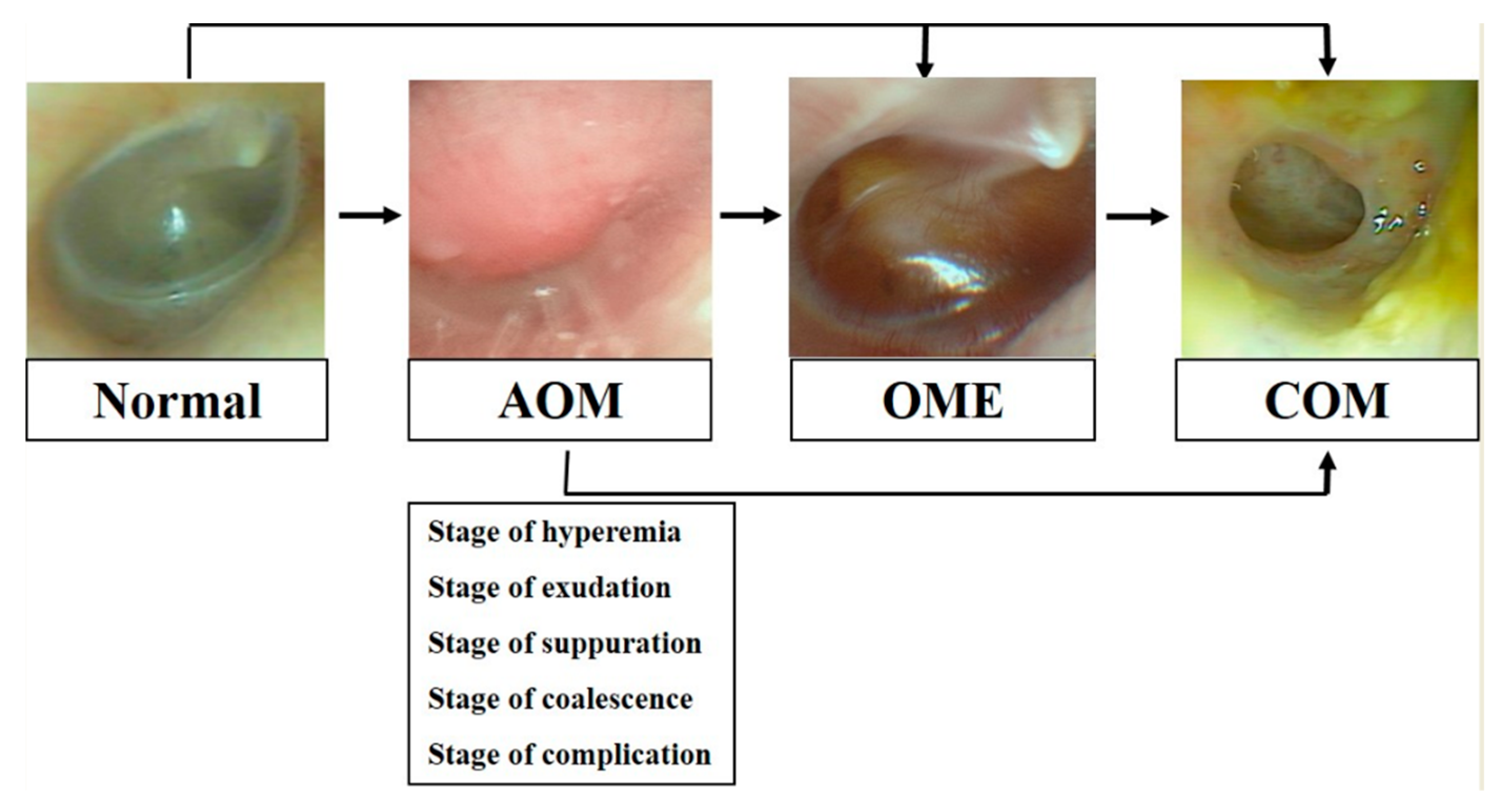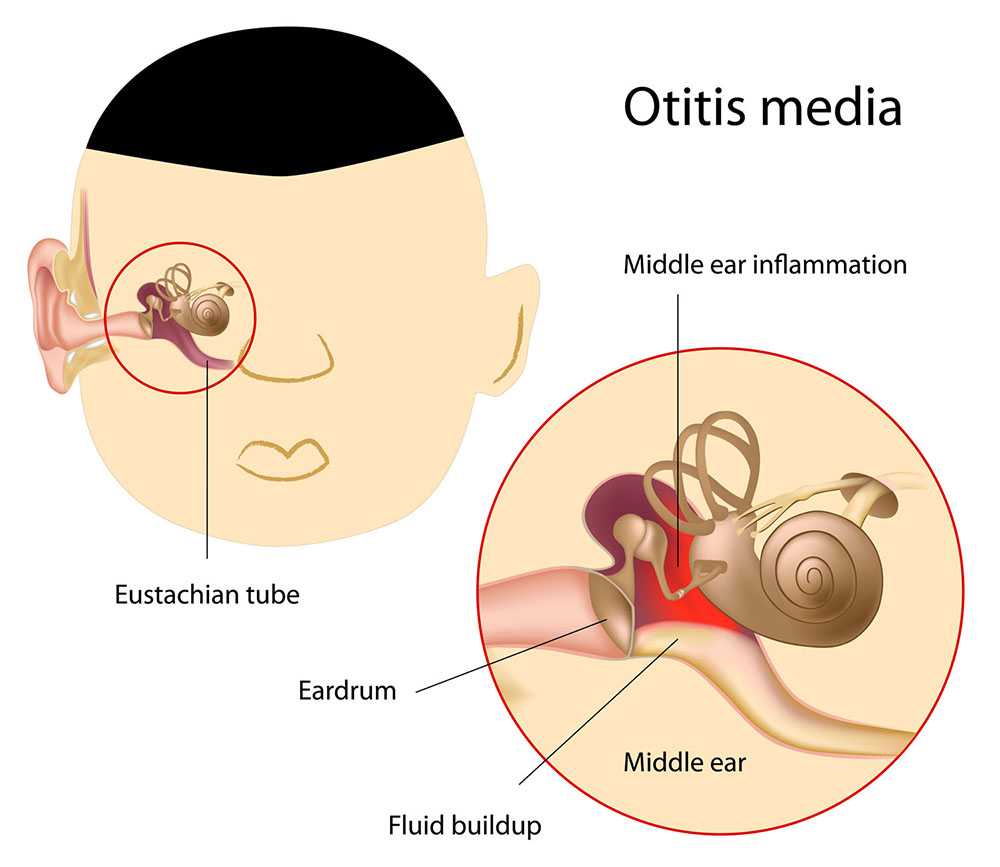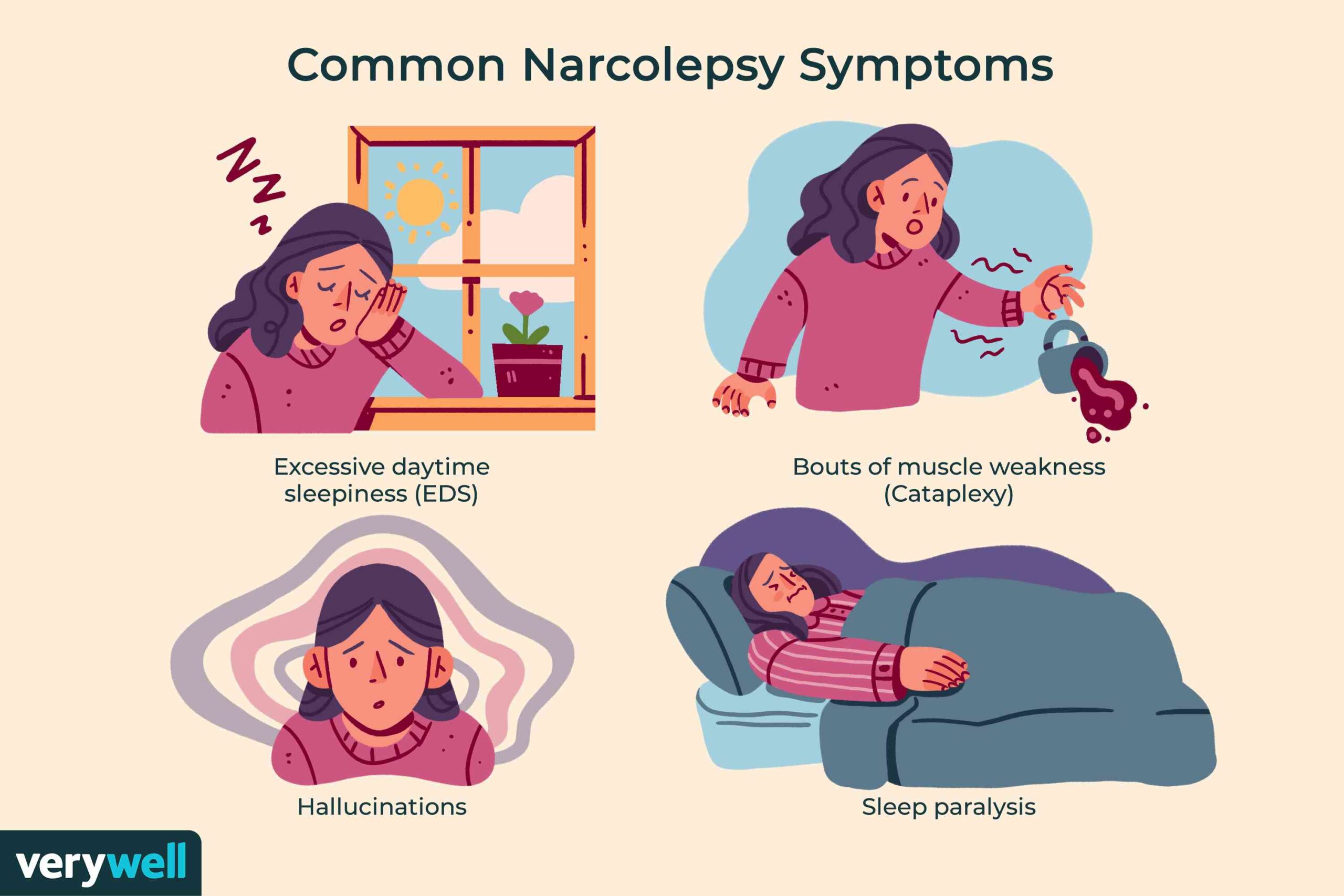Otitis Media Nonsuppurative -various aspects-
Introduction –
What does otitis media with nonsuppurative mean?
Nonsuppurative otitis media lacks pus production while suppurative otitis media causes fluid to build up in the ear. Eustachian tube illness and acute serous otitis media are linked to non-suppurative otitis media, commonly known as non-suppurative otitis media.
Otitis media with effusion (OME) is a condition in which there is fluid in the middle ear but no signs of acute infection. As fluid builds up in the middle ear and Eustachian tube, it places pressure on the tympanic membrane. The pressure prevents the tympanic membrane from vibrating properly, decreases sound conduction, and therefore results in decreased hearing. Non-suppurative otitis media symptoms The primary local symptoms of acute nonsuppurative otitis media are persistent, irritable ear pain that might be accompanied by pulling and covering of the ears, which most frequently interferes with sleep.
Following an acute upper respiratory tract infection, acute nonsuppurative otitis media affects the mouth, cartilage segments, and the tubal pharynx. It is characterized by inflammatory mucosal hyperemia, swelling, and congestion, and it may be accompanied by bacteria or viruses that enter the middle ear cavity through the eustachian tube.


What is the difference between suppurative and non suppurative otitis media?
What is the difference between otitis media with effusion and serous otitis media ?
What are the three types of otitis media?


Is Otitis media with effusion non suppurative ?
What is best treatment of Otitis media ?
How does ENT drain fluid from ear?
Can antibiotics get rid of fluid in ear?
Which tablet is best for ear pain ?
What is the course of treatment for otitis media nonsuppurative ?
The majority of people can be effectively treated with an analgesic such acetaminophen or a nonsteroidal anti-inflammatory drug. First antibiotic of choice: Amoxicillin-clavulanate is the first line of treatment that we recommend. Amoxicillin 875 mg and clavulanate 125 mg are used orally twice day to most adults.
Rehabilitation of the Eustachian tube can include muscle strengthening exercises for the tensor veli palatini and levator veli palatini muscles via auto-insufflation, breathing exercises, and education for the improvement of nasal hygiene.
For treatment of Otitis media non suppurative you may contact ENT specialist doctor Dr Sagar Rajkuwar( MS-ENT) at the following adress-
Prabha ENT clinic, plot no 345,Saigram colony, opposite Indoline furniture, Ambad link road ,Ambad ,1 km from Pathardi phata ,Nashik ,422010,Maharashtra,India-Dr Sagar Rajkuwar (MS-ENT),ENT
(Ear,Nose,Throat),specialist doctor . Cel no- 7387590194 9892596635
website-
www.entspecialistinnashik.com
When patiently watched after, otitis media nonsuppurative usually resolves on its own. On the other hand, myringotomy combined with tympanostomy tube insertion is seen to be a successful treatment if it persists. A ventilation tube is used in this procedure to get air into the middle ear, which stops fluid from building up again. Many patients do not require further therapy following this procedure since the Eustachian tube angle will grow and develop, allowing for drainage. The development of persistent otorrhea is the most frequent consequence. After 4 weeks of surgery, otorrhea is observed in approximately 1 in 6 (16%) of children, and in 26% of children during the duration that the tube is in place.
Adenoidectomy is a useful complement to Otitis media nonsuppurative patient care and is currently used in situations with OME including swollen adenoids.
Hearing loss in childhood might impact a child’s language development.[15] As a result, using hearing aids to treat OME may be a non-invasive choice.
A number of factors are taken into consideration by clinicians when deciding which Otitis media nonsuppurative interventional treatment is best for a given patient.
- The patient’s comorbidities
- The degree of hearing loss
- OME’s bilateral or unilateral presence
- Duration of diffusion
- Patient’s age Social circumstances
- Patient expense
- Propensity of the patient to follow their treatment plan
- family support during treatment
Assessing hearing impairments should be done with the patient in mind. The child’s social and academic adjustment is more significant than the findings of audiometry tests. A patient-centered treatment strategy that maximises outcomes for the patient should take into account all physical and social aspects, even if the majority of OME patients will benefit from a conservative management approach rather than more invasive procedures
To understand otitis media nonsuppurative it is necessary to have a brief idea of the anatomy of the middle ear.The middle ear, which is situated behind the eardrum, contains the small bones that contribute to hearing (tympanic membrane). These bones are the stirrup (ossicles), incus (anvil bone), and malleus (hammer bone) (stapes). To gain a better understanding, let’s look at the ear’s overall structure and functioning:
The ear is made up of the auditory canal, eardrum (also known as the tympanic membrane), and inner ear. The middle ear is the region that lies between the eardrum and the inner ear.
Operation and design of the ear-
The three main parts of the ear are the outer, middle, and inner. To understand otitis media nonsuppurative it is necessary to have a brief idea of the anatomy of the middle ear
The outer ear is made up of the external ear flap and ear canal (external auditory canal).
The air-filled middle ear lies between the tympanic membrane (eardrum) and the inner ear. The middle ear is home to the delicate bones that transmit sound vibrations from the eardrum to the inner ear. Ear infections can be found here.
The inner ear’s snail-shaped labyrinth is where middle ear sound waves are converted into electrical signals. The auditory nerve conveys these impulses to the brain.
Other nearby areas
The eustachian tube, which joins the middle ear to the upper neck, regulates the air pressure in the middle ear.
Over the neck, behind the nose, and adjacent to the eustachian tubes are little tissue pads called adenoids. Adenoids support the body’s defence against illnesses brought on by oral bacteria.
The following are ear infection risk factors: otitis media .Otitis media is different from otitis media nonsuppurative
Age: Infants and young children are most likely to have ear infections called otitis media (between the ages of 6 months and 2 years).
Children with development anomalies including the palate, palate muscles, decreased muscle tone for palate muscles, or bone development variations are at increased risk of development of OME, e.g., cleft palate, Down Syndrome. Beyond these anatomical variations, patients with Downs syndrome can have mucociliary function disorders that increase the risk of developing OME.(otitis media nonsuppurative)
Family history: Ear infections are prone to run in families.
Frequent colds: Frequent colds increase your risk of getting an ear infection.
Allergies: Allergies can enlarge the adenoids by inflaming (swelling) the upper respiratory tract and nasal passages. Enlarged adenoids may clog the eustachian tube, preventing the drainage of ear fluids. This causes fluid to build in the middle ear, which can result in pressure, discomfort, and infection.
Chronic illnesses: Ear infections are more likely to occur in patients with immune system deficits and chronic respiratory diseases such cystic fibrosis and asthma.
Otitis media in children of Native American and Hispanic heritage is more common than in children of other racial groups.
Following nasopharyngeal cancer, radiation therapy may result in a number of problems. The most frequent side effect is xerostomia, or dry mouth brought on by insufficient saliva. A persistent OME may occasionally arise, making further medication or surgical intervention necessary.
Pathophysiology of otitis media non suppurative-
Children who have an acute otitis media have fluid accumulation in the middle ear, which prevents the tympanic membrane from vibrating and subsequently blocks sound from entering the inner ear. Children may find it more difficult to communicate in noisy settings as a result of this deficiency. The child’s academic performance may suffer or they may exhibit indicators of inattention.
In patients with large adenoids, the adenoids can obstruct the Eustachian tube resulting in a poorly ventilated middle ear. This type of blockage may result in OME. Because the adenoids are a lymphatic structure, it is possible that they can transmit bacteria into the Eustachian tube and allow the growth of biofilms. Such bacterial growth can cause inflammation that would also facilitate blockage and fluid build-up within the middle ear.
Epidemiology of Otitis media non suppurative
OME is one of the most frequent infectious diseases in children and is the most common cause of acquired hearing loss in childhood. The disease commonly affects children between the ages of 1 and 6. There is a higher prevalence at the age of 2, which drops after the age of 5. OME is more prevalent during the winter months, corresponding to higher patient rates of upper respiratory infections.
History and Physical examination in otitis media non suppurative–
The most prevalent complaint among OME sufferers, though it’s not always present, is hearing loss. Patients’ or their parents’ complaints of poor communication, disengagement, and inattention are common. A clinician may see delayed speech and language development during an examination. These individuals may experience sporadic otalgia and ear pain. They frequently experience auditory fullness or a popping sensation in one or both ears. OME is more frequently unilateral in adulthood.
Tinnitus and the feeling that something is strange in the external auditory canal are common complaints from adult patients. It is typical for OME to develop alongside upper respiratory illnesses in both adults and children. Thus, it is a good idea to enquire about nasal obstruction, upper respiratory tract infections, and previous or recurring ear infections from patients.
Evaluation in otitis media non suppurative-
Patients diagnosed with otitis media with effusion should undergo age-appropriate tympanometry and audiometry testing. An otitis media with effusion diagnosis will be supported by a “flat” tympanogram. [10]Baby hearing can be assessed using auditory brainstem responses (ABR). This test measures the brainstem’s electrical response to auditory stimulation. The test determines the spectrum of frequencies and intensities of sound that the patient’s brain reacts to. For the test to be performed, patients do not even need to be awake or able to communicate. As a result, it is perfect for kids under five years old.
While standard audiology exams are more frequently used, ABR testing is still an option for older children and adults. During this examination, sounds of varying tones and intensities are played into the patient’s left and right ears. When a patient hears sound in their left or right ear, they are asked to raise their hand accordingly. The patient’s typical hearing levels and frequency range will be determined by the results.
A normal person requires a sound to be louder in order to discern high frequencies over lower frequencies because people with normal hearing can detect lower frequencies at a lower decibel (or intensity) than higher frequencies. An audio graph is used to plot the frequency range that a person may perceive during an audiology exam. On the audio graph, those with OME have a lower decibel (dB) range.
Levels of hearing loss (decrease from normal levels of hearing thresholds):
- 26–40 dB of slight impairment.
- 41–60 dB of moderate impairment
- Abnormal hearing: 61–80 dB
- Hearing loss severity: 71-90 dB
- Deafness and other severe impairments measured at 81 dB or above.
Complications of Otitis media non suppurative-
Persistent OME may cause long-term alterations to the tympanic membrane and middle ear, which could lead to irreversible hearing loss. The goal of using ventilation tubes is to attempt to avoid these chronic problems. Nevertheless, side effects like tympanosclerosis can happen to people who are receiving treatment.
Otitis media: IMPORTANCE AND CAUSES- Otitis media is different from otitis media nonsuppurative .Why do ears get sick?
The two main causes of ear infections are bacteria and viruses. A cold or another respiratory infection is usually followed by an ear infection. The eustachian tube, which is located in each ear, allows bacteria or viruses to enter the middle ear. This tube connects the middle ear to the back of the throat. The bacteria or virus may cause the eustachian tube to enlarge. The growth may cause the tube to become clogged, which would prevent the normal production of fluids from being drained away and would cause them to build up in the middle ear.
It doesn’t help that children’s eustachian tubes are shorter and slope less than those of adults. These tubes are more likely to clog and more difficult to empty due to their physical characteristics. An infection of the confined fluid by bacteria or viruses could cause pain.
The previously described middle ear infection is known as acute otitis media. Otitis media is different from otitis media nonsuppurative ,an unanticipated ear infection that frequently comes after a cold or another respiratory condition. A “ear infection” is a disorder where bacteria or a virus infects and retains fluid behind the eardrum, causing discomfort, eardrum swelling or bulging, and other symptoms. An ear infection known as acute otitis media manifests rapidly and goes away swiftly. Some ear infections recur frequently and last for a long time (chronic middle ear infections).
Otitis media with effusion may develop after an acute otitis media. Otitis media is different from otitis media nonsuppurative . The symptoms of acute otitis media disappear. The fluid is still there even when the sickness is dormant. The buildup of fluid can temporarily impair hearing and raise the risk of ear infections. Another cause of this sickness, unrelated to the ear infection, is a clog in the eustachian tube.
Chronic suppurative otitis media which is different from otitis media nonsuppurative- refers to an ear infection that persists despite medical intervention. As a result, the eardrum may eventually develop a hole.
Who is most prone to getting an ear infection (otitis media)? Conditions for otitis media nonsuppurative are different than those for otitis media .
The most common illness in children is middle ear infection (other than a cold). Although they can occur up to age 8, ear infections are most common in children between the ages of three months and three years. Recurrent ear infections will affect one-fourth of all children.
Even though adult ear infections are much less common than those in children, they are nonetheless possible.
The following are ear infection risk factors for otitis media-(Risk factors for otitis media nonsuppurative are different than those for otitis media .
Age: Infants and young children are most likely to have ear infections called otitis media (between the ages of 6 months and 2 years).
Family history: There is a tendency for ear infections to run in families.
Frequent colds: Frequent colds increase your risk of getting an ear infection.
Allergies: Allergies can enlarge the adenoids by inflaming (swelling) the upper respiratory tract and nasal passages. Enlarged adenoids may clog the eustachian tube, preventing the drainage of ear fluids: In the middle ear, fluid builds up as a result of this, which can cause pressure, discomfort, and infection.
Chronic illnesses: Ear infections are more likely to occur in patients with immune system deficits and chronic respiratory diseases such cystic fibrosis and asthma.
Otitis media in children of Native American and Hispanic heritage is more common than in children of other racial groups.
For treatment of Otitis media non suppurative you may contact ENT specialist doctor Dr Sagar Rajkuwar( MS-ENT) at the following adress-
Prabha ENT clinic, plot no 345,Saigram colony, opposite Indoline furniture, Ambad link road ,Ambad ,1 km from Pathardi phata ,Nashik ,422010,Maharashtra,India-Dr Sagar Rajkuwar (MS-
ENT),ENT (Ear,Nose,Throat),specialist doctor . Cel no- 7387590194 9892596635
website-
www.entspecialistinnashik.com
Below we have given link of one you tube video on non suppurative otitis media .But just going through this short video is not sufficient. For complete information it is necessary to through this article on non suppurative otitis media in detail .
|
ReplyForward
|
Nonsuppurative otitis media refers to a middle ear infection characterized by fluid accumulation without the presence of pus. It is a frequent source of hearing difficulties in children.
Symptoms
- Ear discomfort, which may be ongoing and disrupt sleep
- Irritability
- Tugging or covering the ears
- Mild nasal congestion
- Recessed tympanic membrane
- Cloudy, pale yellow, or amber fluid present in the middle ear
Causes
- A respiratory tract infection may trigger inflammation in the mucosa of the middle ear
- Bacteria or viruses can enter the middle ear through the eustachian tubes
- Obstruction of the eustachian tubes may occur, potentially resulting in fluid accumulation
Effects
- Conductive hearing impairment
- Impediments to speech, language, and cognitive development
Who is affected?
- Nonsuppurative otitis media frequently occurs in children, particularly those with cleft palates or Down’s syndrome
- While older children and adults can experience ear infections, it is less common compared to young children
Otitis media nonsuppurative icd 10
The ICD-10 code for nonsuppurative otitis media is H65.
Explanation:
H65: This code specifically denotes “nonsuppurative otitis media,” indicating that there is fluid accumulation in the middle ear without any pus present.
Important points to remember:
To indicate which ear is affected (right, left, or bilateral), you can append the suitable modifier to the code.
For a more precise diagnosis of “other acute nonsuppurative otitis media,” utilize code H65. 19.
Nonsuppurative otitis media symptoms
Symptoms
- Ear pain, especially when lying down
- Difficulty sleeping
- Tugging or pulling at the ear
- Fever, especially in children
- Fluid draining from the ear
- Loss of balance
- Hearing difficulties
- Irritability
- Behavioral problems, such as withdrawal, poor concentration, or balance difficulties
Nonsuppurative otitis media treatment
Treatment for nonsuppurative otitis media generally focuses on alleviating symptoms such as pain with over-the-counter medications like acetaminophen or ibuprofen, addressing underlying issues such as allergies, and in cases of persistence, may involve myringotomy with tympanostomy tube placement to drain fluid accumulation in the middle ear and enhance hearing; at times, depending on severity, antibiotics might be considered, but this is less frequent than with suppurative otitis media.




